United States History Writing Study Skills
Frank Warren, a history professor at Queens College and a former Chief Faculty Consultant for AP U.S. History, offers the following suggestions for writing a good response to a document-based question (DBQ) or free-response essay question.

Write More Often
AP students need to write, and to write often. This practice is an excellent way to develop the skill of casting a thesis statement and marshalling evidence in support of a valid generalization.
Define Your Terms Where Necessary
Look especially at terms like liberal or conservative, radical or progressive. Be prepared to define other central terms, such as major change, that may appear to be obvious but can be ambiguous.
Start with a Clearly Stated Thesis
Some good essay writers begin with a thesis statement, back it up with supporting evidence from documents and outside knowledge, and, if time permits, restate the thesis at the end. Other writers analyze the material and build up logically to their thesis statement. On an AP Exam, you should use whichever method you feel most comfortable with. In any case, exam day is probably not a good time to experiment with a new, unfamiliar method of writing.
Organize Your Response Carefully
In addition to having a strong thesis, it is a good idea to have a guiding organizational principle—a stated agenda for making your point. Try to integrate your outside information into your response. Your exam shouldn’t read as if you threw in a few tidbits of outside information at the end.
Make Sure Thesis Matches Assessment and Knowledge
Many good essay writers demonstrate a sense of complexity in the documents, showing that most of the evidence may point in one direction but that part of the evidence points in a different direction. It is better, however, to support a clear, simple thesis than to create artificially a complexity that you can't support using the documents or outside knowledge. Almost every essay—including the DBQ—is designed to allow the student to agree or disagree with the statement. Your ultimate goal should be to present a well-argued and well-supported thesis, not merely to give the people scoring the essay what you think they want.
Build an Argument
The best essays—in terms of arguing their case—are those that marshal the positive arguments in favor of their position but that also refute or answer possible rival theses. Even if you think a statement is completely true, it is better to confront and negate the evidence that seems to refute it than to ignore the counterevidence completely.
Integrate the Documents and Your Analysis
Don’t merely explain what is stated in the documents. Rather, use the documents as part of an integrated essay in support of your thesis.
Don’t Quote Large Portions of the Documents
The readers of the essays are already familiar with the documents. You can quote a short passage or two if necessary, to make your point, but don’t waste time or space reciting them.
Choose Your Essays Wisely
Select the questions you are best prepared to answer. The questions that invite the easiest generalizations are not always the ones you should answer. As you read through the questions and make your choices, ask yourself for which of the questions are you best prepared to support your thesis.

AP® US History
Ensuring your students earn the contextualization point on the dbq.
- The Albert Team
- Last Updated On: March 1, 2022

The redesign has brought a great deal of uncertainty and confusion amongst APUSH teachers. In many ways, we are all “rookie” teachers, as all of us have the challenge of implementing fundamental curricular and skills-based changes into our classrooms.
One of the more significant changes is to the structure of one essay on the AP® exam, the Document Based question (DBQ). The rubric for the DBQ was previously a more holistic essay that combined a strong thesis, and use of documents and outside information to support the argument. This has been transformed into a much more structured and formulaic skills-based rubric. The change has led to a healthy debate about the pros and cons of both types of essays, but in general the core of the essay has remained the same: write a thesis and support it with evidence in the form of documents and outside information. If students continue to apply these basic writing skills, they are likely to earn 3 or 4 out of the seven total points for the Document Based Question .
In this post, we will explore one of these points students will be looking to earn to help their chances at passing the APUSH exam this May: the Contextualization point.
What is Contextualization?
According to the College Board, contextualization refers to a:
Historical thinking skill that involves the ability to connect historical events and processes to specific circumstances of time and place as well as broader regional, national, or global processes. ( College Board AP® Course and Exam Description, AP® US History, Fall 2015 )
Contextualization is a critical historical thinking skill that is featured in the newly redesigned course. In my opinion, this is a skill of fundamental importance for students to utilize in the classroom. Often times, students find history difficult or boring because they don’t see connections between different historical time periods and the world they live in today. They assume that events occur in a vacuum, and don’t realize that the historical context is critical in helping explain people’s beliefs and points of view in that period of time. Putting events into context is something I always thought was important, but now that the College Board explicitly has established the skill, it has forced me to be more proactive in creating lessons and assignments that allow students to utilize this way of thinking.
The place that contextualization is most directly relevant on the actual AP® exam itself is the Document Based Question. In order to earn the point for contextualization, students must:
Situate historical events, developments, or processes within the broader regional, national, or global context in which they occurred in order to draw conclusions about their relative significance. (College Board AP® Course and Exam Description, AP® US History, Fall 2015)
In other words, students are asked to provide background before jumping right into their thesis and essay and paint a picture of what is going on at the time of the prompt. Although there is no specific requirement as to where contextualization should occur, it makes natural sense to place it in the introduction right before a thesis point. Placing this historical background right at the beginning sets the stage for the argument that will occur in the body of the essay, and is consistent with expectations many English teachers have in how to write an introduction paragraph.
I explain contextualization to students by using the example of Star Wars. Before the movie starts, the film begins with “A long time ago in a galaxy far, far away…” and continues with background information on the characters, events, and other information that is crucial to understanding the film. Without this context, the viewer would not know what is going on, and might miss key events or be lost throughout the film. This is what contextualization aims to do in student essays. It sets the stage for their thesis, evidence, and argument that is to follow.
Contextualization vs. Historical Context
One aspect of the DBQ rubric that can be a bit confusing initially is that students are asked to do this contextualization, but there is also another area which gives them the option to use historical context. So what is the difference?
Contextualization refers to putting the entire essay into a broader context (preferably in the introduction). However, when writing their essays, students are also required to analyze four of the documents that they utilize by either examining the author’s point of view, describing the intended audience of the source, identifying the author’s purpose or putting the source into historical context. The latter sounds similar to contextualization (and it is essentially the same skill), but historical context is only focused on the specific document being analyzed, not the entire essay, like the contextualization point. For example, if a document is a map that shows slavery growing dramatically from 1820 to 1860, a student might point out that this growth can be explained in the context of the development of the cotton gin, which made the production of cotton much more profitable and let to the spread of slavery in the Deep South. While essentially the same skill, historical context focuses on one specific document’s background.
Examples of Successful Student Contextualization Points
One of the biggest pitfalls that prevent students from earning the contextualization point is that they are too brief or vague. In general, it would be difficult for students to earn the point if they are writing only a sentence or two. Early in the year, I assigned students a DBQ based on the following prompt:
Evaluate the extent in which the Civil War was a turning point in the lives of African Americans in the United States. Use the documents and your knowledge of the years 1860-1877 to construct your response.
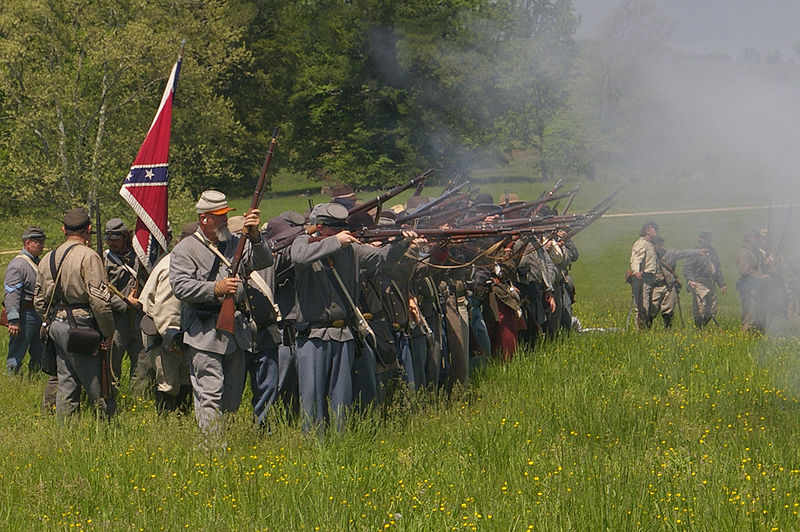
This was the third DBQ we had written, and students were now getting brave enough to move beyond a thesis and document analysis and started attempting to tackle the contextualization point. However, the attempts were all over the map. One student wrote:
The Civil War was a bloody event that led to the death of thousands of Americans.
Of course this is a true statement, but is extremely vague. What led to the Civil War? Why was it so deadly? Without any specific detail, this student could not earn the contextualization point.
Another student wrote:
Slavery had existed for hundreds of years in the United States. It was a terrible thing that had to be abolished.
Again, this is a drive-by attempt at earning contextualization. It mentions things that are true, but lacks any meaningful details or explanation that would demonstrate understanding of the time period in discussion. What led to the beginning of slavery in the colonies? How did it develop? What made it so horrible? How did individuals resist and protest slavery? These are the types of details that would add meaning to contextualization.
One student nailed it. She wrote:
The peculiar institution of slavery had been a part of America’s identity since the founding of the original English colony at Jamestown. In the early years, compromise was key to avoiding the moral question, but as America entered the mid 19th century sectional tensions and crises with popular sovereignty, Kansas, and fugitive slaves made the issue increasingly unavoidable. When the Civil War began, the war was transformed from one to simply save the Union to a battle for the future of slavery and freedom in the United States.
Now THAT is contextualization! It gives specific details about the beginning of slavery and its development. It discusses attempts at compromise, but increasing sectional tensions that led to the Civil War. The writer paints a vivid and clear picture of the situation, events, and people that set the stage for the Civil War. Students don’t want to write a 6-8 sentence paragraph (they will want to save time for their argument in the body), but they need to do more than write a vague sentence that superficially addresses the era.
Strategies for Teaching Contextualization to Students
Analyze Lots of Primary Sources One of the best ways to prepare for the DBQ is for students to practice reading and comprehending primary source texts, particularly texts that are written by people who use very different language and sentence structure from today. This helps them understand and analyze documents, but it also can be helpful in practicing contextualization. Looking at different perspectives and points of view in the actual historical time periods they are learning is key in allowing students to understand how the era can impact beliefs, values and events that occur.
Assign Many DBQ Assessments and Share Specific Examples The more often students write DBQs, the more comfortable students will get with the entire process and skill set involved, including contextualization. One thing that has been especially successful in my classroom is to collect a handful of student attempts at the contextualization point and share them with students. Students then get to examine them and look at effective and less effective attempts at earning contextualization. Often the best way for students to learn what to do or how to improve is to see what their classmates have done.
Incorporating In-Class Activities The course is broken into nine distinct time periods from 1491 to present. In each period or unit students are assigned activities that force them to put a specific policy, event, or movement into context. For example, we did lecture notes on the presidency of JFK, learning about the Man on the Moon Speech, Cuban Missile Crisis, and creation of the Peace Corps. Students had to write 3-4 sentences that asked them to put these events in historical context using the Cold War. This allowed students to understand that each of these seemingly unrelated historical events were shaped by the tension between the United States and Soviet Union: winning the space race, stopping a communist nuclear threat less than 100 miles from Florida, and spreading goodwill into nations that might otherwise turn to communism all are strategies the United States used to thwart the Soviet threat. By doing this activity, students gain an appreciation for how historical context shapes events and decisions of the day.

Teach Cause and Effect in United States History It is very easy to get caught up as a teacher in how to best get lots of minutia and factoids into students heads quickly and efficiently. However, if we can teach history not as a series of independent and unrelated events, but as a series of events that have a causal relationship that impact what happens next, this helps students grasp and understand contextualization. For example, in the lead-up to World War I, students create a timeline of events that led to America entering the conflict. As students examine the torpedoing of the Lusitania, unrestricted submarine warfare, the Zimmermann telegram, etc., they gain an understanding that it was not a random decision by President Wilson, but rather a series of events that precipitated the declaration of war. This is what contextualization is: the background that sets the stage for a particular moment in American history.
Examine Contextualization with Current Events I know what you are thinking, I have one school year (less if your school year starts in September) to get through 1491 to Present and now I am supposed to make this a current events class as well? The answer is yes and no. Will stuff from the news pages be content the students need to know for the exam: absolutely not. However, it is a great opportunity for students to understand that our past explains why our country is what it is today.
For example, President Obama’s decision to work towards normalizing relations with Cuba makes more sense if students think about it through the lens of contextualization. The United States invaded Cuba in 1898 in the Spanish-American War and set up a protectorate. Cubans, upset with what they perceived as U.S. meddling and intervention led a communist revolution in 1959, ousting the American-backed government and setting the stage for one of the scariest moments in the Cold War : the Cuban Missile Crisis. Looking at how the past shapes current events today helps students understand this skill, and it also helps them gain a deeper appreciation of how important history is in shaping the world around them.
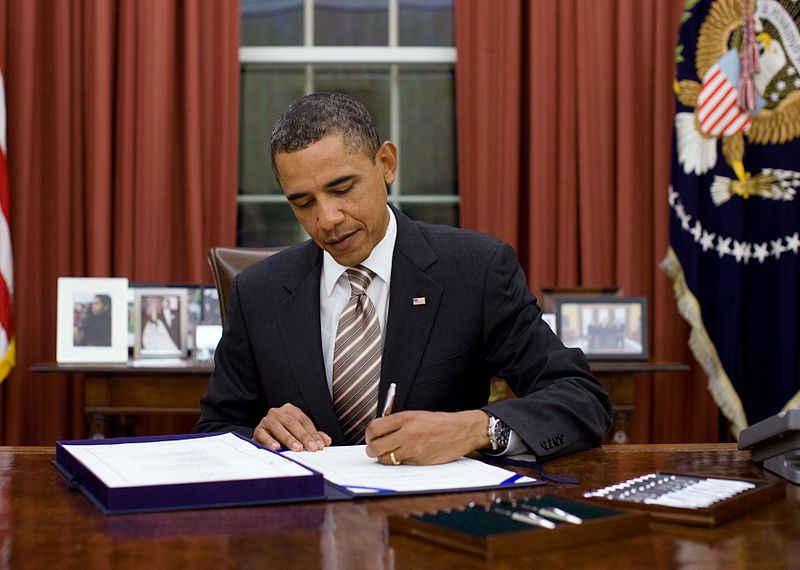
Any time changes happen, there is a temptation to be reactionary and reject them. I have found that by being more deliberate about helping students understand historical context, their engagement and understanding have improved significantly. Teachers always are fighting that battle between covering the content (which is daunting in an AP® course) and helping students understand the “so what?” question. Why does this matter to me? By making connections, students can see that history does not every happen in a vacuum. Our shared narrative is a series of events and ideas that continuously evolve and build off of each other. When students gain a firm understanding of how the past impacts their lives today, it makes learning way more meaningful and fun.
Contextualization is tough for students at first, but it is a skill application that can be perfected and improved to maximize your students’ chances of earning that point and rocking the AP® exam.
Looking for AP® US History practice?
Kickstart your AP® US History prep with Albert. Start your AP® exam prep today .
We also go over five-steps to writing effective FRQs for AP® US History in this video:

Ben Hubing is an educator at Greendale High School in Greendale, Wisconsin. Ben has taught AP® U.S. History and AP® U.S. Government and Politics for the last eight years and was a reader last year for the AP® U.S. History Short Answer. Ben earned his Bachelors degree at The University of Wisconsin-Madison and Masters degree at Cardinal Stritch University in Milwaukee, Wisconsin.
Interested in a school license?
4 thoughts on “ensuring your students earn the contextualization point on the dbq”.
great very helpful!
Glad it helped!
Very useful, thank you.
Glad it was helpful!
Comments are closed.
Popular Posts

AP® Score Calculators
Simulate how different MCQ and FRQ scores translate into AP® scores

AP® Review Guides
The ultimate review guides for AP® subjects to help you plan and structure your prep.

Core Subject Review Guides
Review the most important topics in Physics and Algebra 1 .

SAT® Score Calculator
See how scores on each section impacts your overall SAT® score

ACT® Score Calculator
See how scores on each section impacts your overall ACT® score

Grammar Review Hub
Comprehensive review of grammar skills

AP® Posters
Download updated posters summarizing the main topics and structure for each AP® exam.

Choose Your Test
- Search Blogs By Category
- College Admissions
- AP and IB Exams
- GPA and Coursework
The Ultimate Guide to the AP US History Exam
Advanced Placement (AP)

The AP US History exam involves critical reading, writing, and in-depth analysis. It's not just about memorizing names and dates, but rather interpreting historical evidence quickly and accurately, recalling outside information on a topic, and synthesizing your ideas into a coherent argument.
In this guide, we'll give you a rundown of the format and structure of the AP US History test along with a brief content outline, sample questions, and some tips for a great score .
How Is the AP US History Exam Structured?
The next AP US History test will be administered on Friday, May 5, 2023, at 8 AM . This AP exam is three hours and 15 minutes long and consists of two main sections, each of which is divided into a Part A and a Part B.
Before we get into the details of each part, here's an overview of the US History test as a whole:
| 1A | Multiple Choice | 55 | 55 mins | 40% |
| 1B | Short Answer | 3 (for third, choose 1 of 2 prompts) | 40 mins | 20% |
| 2A | Document-Based Question (DBQ) | 1 | 60 mins (including a 15-min reading period) | 25% |
| 2B | Long Essay | 1 (choose 1 of 3 prompts) | 40 mins | 15% |
Section 1, Part A: Multiple Choice
The first section on the test is the multiple-choice section, which is worth 40% of your score and lasts for 55 minutes. You'll get 55 questions, each with four possible answer choices (labeled A-D); this means that you'll have about a minute per question on this part of the exam.
Most US History multiple-choice questions come in sets of three to four questions that require you to respond to certain stimuli, or sources, such as historical texts, graphs, and maps.
Section 1, Part B: Short Answer
Part B of Section 1 on the US History test requires you to answer three short-answer questions in 40 minutes , giving you about 13 minutes per question. It's worth 20% of your overall score.
The first two questions are required, but you get to choose between question 3 and question 4 for your third short answer . Here's what you can expect with each question:
| Prompt 1 | 1754-1980 | 1-2 secondary sources |
| Prompt 2 | 1754-1980 | 1 primary source |
| Prompt 3 | 1491-1877 | No stimulus |
| Prompt 4 | 1865-2001 | No stimulus |
Section 2, Part A: Document-Based Question
The Document-Based Question, or DBQ , is worth 25% of your final score and requires you to write an essay based on a prompt that's accompanied by seven historical documents . You'll get a 15-minute reading period followed by 45 minutes to write your response.
The DBQ will focus on a historical development in the years 1754-1980.
Section 2, Part B: Long Essay
The final part of the AP US History test is the Long Essay, for which you must choose one of three possible prompts and write an essay on the topic. You'll have 40 minutes to write your response, which will count for 15% of your overall AP score.
To earn full credit here, you must develop a clear and logical argument and support it with relevant historical evidence (which won't be directly provided to you as it will be on the DBQ).
Each of the three essay prompts revolves around a different time period in US history:
- Essay Prompt 1: 1491-1800
- Essay Prompt 2: 1800-1898
- Essay Prompt 3: 1890-2001
Content Background for the AP US History Exam
There are eight themes addressed in the AP US History course , and all of them show up in one form or another on the exam across the nine units, or time periods . Each represents a subset of learning objectives that students are expected to master. You can read more about these learning objectives in the AP US History Course and Exam Description .
Before I give you a broad overview of the eight themes, let's take a look at how the major units are weighted on the AP US History exam :
| Unit 1: 1491-1607 | 4-6% |
| Unit 2: 1607-1754 | 6-8% |
| Unit 3: 1754-1800 | 10-17% |
| Unit 4: 1800-1848 | 10-17% |
| Unit 5: 1844-1877 | 10-17% |
| Unit 6: 1865-1898 | 10-17% |
| Unit 7: 1890-1945 | 10-17% |
| Unit 8: 1945-1980 | 10-17% |
| Unit 9: 1980-Present | 4-6% |
Below, we give you the definition of each course theme as described in the AP US History Course Description.
Theme 1: American and National Identity
Focuses on how and why definitions of American and national identity and values have developed among the diverse and changing population of North America as well as on related topics, such as citizenship, constitutionalism, foreign policy, assimilation, and American exceptionalism.
Theme 2: Work, Exchange, and Technology
Focuses on the factors behind the development of systems of economic exchange, particularly the role of technology, economic markets, and government.
Theme 3: Geography and the Environment
Focuses on the role of geography and both the natural and human-made environments in the social and political developments in what would become the United States.
Theme 4: Migration and Settlement
Focuses on why and how the various people who moved to and within the United States both adapted to and transformed their new social and physical environments.
Theme 5: Politics and Power
Focuses on how different social and political groups have influenced society and government in the United States as well as how political beliefs and institutions have changed over time.
Theme 6: America in the World
Focuses on the interactions between nations that affected North American history in the colonial period and on the influence of the United States on world affairs.
Theme 7: American and Regional Culture
Focuses on how and why national, regional, and group cultures developed and changed as well as how culture has shaped government policy and the economy.
Theme 8: Social Structures
Focuses on how and why systems of social organization develop and change as well as the impact that these systems have on the broader society.

Sample AP US History Questions
Now that you have a sense of the test content, I'll present you with sample questions to give you a better idea of what the AP US History exam actually looks like. All sample questions come from the official US History Course and Exam Description .

Sample Multiple-Choice Question
For multiple choice, you're given one or two pieces of historical evidence followed by a set of questions that ask you to do some analysis . The US History exam is less about knowing specific dates and names and more about being able to draw conclusions and connect themes based on materials provided by the test.
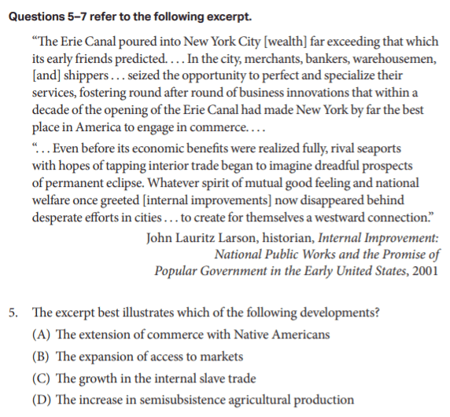
To answer this question, you don't even really need to know much about US history, as long as you pay attention to exactly what's written in the passage, or the secondary source you've been given. The passage here is mainly focused on the increase in commerce in New York as a result of the opening of the Erie Canal.
Answer choice A mentions commerce—that's a good sign—but specifically commerce with Native Americans, who are not mentioned at all in the passage, so this is unlikely to be the right answer.
Answer choice B discusses increased access to markets in the United States, which seems to echo what the passage says about commerce in New York. We'll hold onto this as a potential answer.
Answer choice C is all about the internal slave trade, which isn't mentioned at all in the secondary source, so we can assume this is wrong.
Answer choice D talks about agricultural production, which, again, isn't the focus of the passage—that's commerce. As a result, we can cross this off our list.
This means that the only logical answer to choose is answer choice B .

Sample Short-Answer Question
The short-answer questions are technically considered part of the multiple-choice section because they're less involved than the essay questions. Alt hough they do have multiple parts, you don't have to come up with a thesis—one-sentence answers are OK. These questions are about succinctly connecting themes and reference materials to specific events or trends.
Here's an example:

This short-answer question is an example of question 1, which comes with two secondary sources. As you can see, you'll have to answer three separate parts (A, B, and C), each of which is worth 1 point ; this means you can earn up to 3 points for each short-answer question.
Here's how you could earn full credit for this sample question, per the official scoring guidelines .
(A) Sample Answers
- Peiss argues that pursuits of entertainment in dance halls by working class women created new, legitimate social spaces for women, however Enstand argues that working women's participation in labor politics gave them a new voice and place in the public sphere.
- Peiss links the growth of women in public social life to a commercial culture that provided opportunities for women to enter the public sphere while Enstand argues that women became political actors who demanded a public voice.
(B) Sample Answers
- Like the dance halls, department stores and amusement parks became aspects of the commercial culture that represented new opportunities for women to enjoy public places as legitimate participants.
- The concept of the New Woman became a cultural phenomenon, as the older idea of separate spheres diminished. The idea of the New Woman supported a more public role for women in the early 1900s.
- The growth of cities and urban America gave young women more opportunities to leave rural America and participate in the developments described by Peiss.
- New technologies such as electric lighting made possible new public spaces for personal freedom for women.
(C) Sample Answers
- Women's participation in the suffrage movement, settlement house work, temperance organizing, and the Progressive movement all contributed to modern attitudes about women and increased their roles in the public sphere.
- The ratification of the Nineteenth Amendment to the Constitution gave women the vote and a voice in politics.
- Women were the main participants in the New York shirtwaist strike of 1909. During this strike women made public demands like those described by Enstad.
- Women organized or participated in labor unions such as the International Ladies' Garment Workers' Union (ILGWU) which is an example of their growing voice in the public sphere.
- Working-class women had key public roles in the successful Lawrence (Massachusetts) textile strike of 1912, this demonstrates that women became active political voices through labor movements.

Sample Document-Based Question
With the DBQ , you'll have seven different historical documents to examine . To earn full credit, you must use at least six documents as evidence in your answer. These documents range from transcripts of folk songs, to excerpts from letters and newspapers, to demographic maps.
Here's an example of a DBQ (with one document shown):
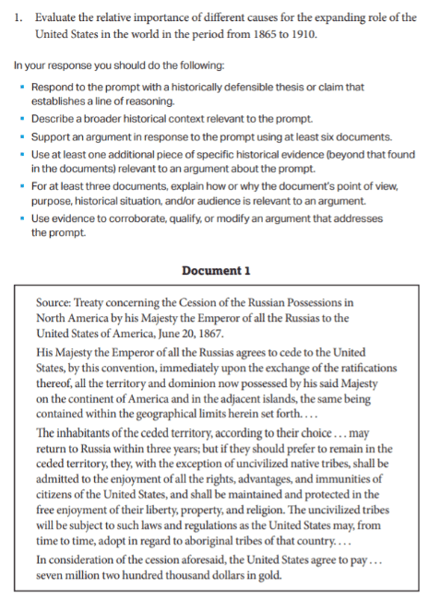
There are several components of a solid response to this question. The DBQ is worth a total of 7 raw points . Here's how you could earn full credit, according to the scoring guidelines .
| Thesis/Claim (0-1 points) | The response must provide a historically defensible thesis or claim about the causes of the expanding role of the United States in the world in the period from 1865 to 1910; the thesis or claim must either provide some indication of the reasoning for making that claim OR by establishing analytic categories of the argument | |
| Contextualization (0-1 points) | Must accurately describe a context relevant to the expanding role of the United States in the world in the period from 1865 to 1910 | |
| Evidence (0-3 points) | Support an argument in response to the prompt by accurately using the content of at least six documents; the six documents do not have to be used in support of a single argument, but they can be used across sub-arguments or to address counterarguments Must use at least one specific piece of historical evidence relevant to an argument about the expanding role of the United States in the world in the period from 1865 to 1910 |
|
| Analysis and Reasoning(0-2 points) | Must explain how or why—rather than simply identifying—the document's point of view, purpose, historical situation, or audience is relevant to an argument that addresses the prompt for each of the three documents sourced Must demonstrate a complex understanding, such as by explaining nuance of an issue by analyzing multiple variables, or by explaining relevant and insightful connections within and across periods, among others |
Sample Long Essay Question
For the Long Essay, you must choose between three prompts . Here's an example of a potential prompt:
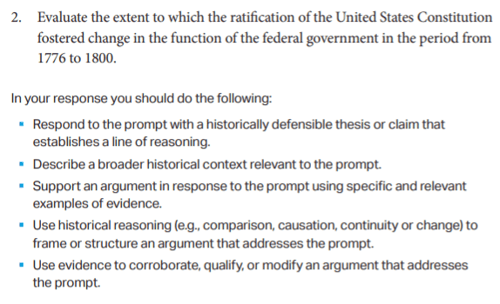
Your essay should include many of the same elements as your answer to the DBQ, but there are no documents to analyze and reference , so you'll have less time to write. The essay is worth 6 raw points .
Here's how you could earn full credit for the sample question above, per the scoring guidelines .
| Thesis/Claim (0-1 points) | The response must provide a historically defensible thesis or claim about how the ratification of the United States Constitution fostered change in the function of the federal government in the period from 1776 to 1800; the thesis or claim must either provide some indication of the reasoning for making that claim OR by establishing analytic categories of the argument | |
| Contextualization (0-1 points) | Must accurately describe a context relevant to the ways in which the ratification of the United States Constitution fostered change in the function of the federal government in the period from 1776 to 1800 | |
| Evidence (0-2 points) | Must use at least two specific historical evidence examples to support an argument regarding how the ratification of the United States Constitution fostered change in the function of the federal government in the period from 1776 to 1800 | |
| Analysis and Reasoning (0-2 points) | Must demonstrate a complex understanding, such as by explaining nuance of an issue by analyzing multiple variables, or by explaining relevant and insightful connections within and across periods, among others | Assessing both Federalist arguments in favor of the Constitution and Anti Federalist arguments against it |

How Is the AP US History Exam Scored?
Here, we'll go over how each section on the AP US History exam is scored, scaled, and combined to give you your final AP score on the 1-5 scale .
On the multiple-choice section, you earn 1 raw point for each question you answer correctly; this means that the max score you can earn here is 55 points. No points are taken off for incorrect answers.
Each of the three short-answer questions is worth 3 points, so there are 9 points possible in this section.
The DBQ is scored out of 7 points and is based on the following criteria, per the scoring guide :
- Thesis/claim: 1 point
- Contextualization: 1 point
- Evidence from the documents: 2 points
- Evidence beyond the documents: 1 point
- Sourcing: 1 point
- Complexity: 1 point
Lastly, the Long Essay is out of 6 raw points and is scored using the following criteria:
- Evidence: 2 points
- Analysis and reasoning: 2 points
On essay questions, points are taken off for errors only if they detract from the quality of the argument being made (in other words, don't go making up historical facts to support your argument). Grammatical and other technical errors aren't a big deal as long as they don't inhibit the grader's ability to understand what your essay is saying.
The total number of raw points you can earn on the AP US History test is 77:
- 55 points for the Multiple Choice questions
- 9 points for the Short Answer questions
- 7 points for the DBQ
- 6 points for the Long Essay
Raw scores can be converted to scaled scores out of 150 . Here's how to do that for each section:
- Multiple Choice: Multiply your raw multiple-choice section score out of 55 by 1.09
- Short Answer: Multiply your raw short-answer score out of 9 by 3.33
- DBQ: Multiply your raw DBQ score out of 7 by 5.36
- Long Essay: Multiply your raw Long Essay score out of 6 by 3.75
Finally, add all the scores together to get your final scaled AP score for US History! Here is a chart to show you approximately how these scaled scores translate to final AP scores:
| 115-150 | 5 | 10.8% |
| 90-114 | 4 | 15.6% |
| 65-89 | 3 | 21.9% |
| 44-64 | 2 | 23.0% |
| 0-43 | 1 | 28.8% |
Source: The College Board
I made my best estimates based on other AP score conversion charts because there was no official scaled-to-AP-score conversion chart online for US History. Your AP teacher or review book might have a more accurate score conversion system you can use for official practice tests.
4 Essential Tips for Acing the AP US History Exam
AP US History is a grueling test that requires intense critical thinking and analytical skills. Here are some helpful tips to remember if you hope to do well on test day.
#1: Don't Confuse Accurate Facts for Correct Answers
Many multiple-choice questions will list answers that are accurate representations of historical events or trends but that don't directly respond to the question being asked . Be wary of these answers on the test so you don't accidentally choose them over more relevant responses.
In the multiple-choice question I gave above as an example, one incorrect choice was "The growth in the internal slave trade." At the time referenced in the question, this was a real trend that occurred, but because it doesn't relate directly to the passage given, it's still the wrong answer .
Don't let these types of answer choices confuse you; adhere to the particulars of the question and the evidence presented to you!
#2: Pay Attention to Details—Read Excerpts Carefully
Most of this AP exam is based on historical reference materials, meaning that you won't be able to answer questions correctly without reading carefully. Even if you know everything there is to know about US History, that knowledge will mostly just serve to contextualize the evidence presented on the test. The specific details found in the writings and images will ultimately reveal the best answer choice.
#3: Plan Before You Write
It's critical to write well-organized, focused essays on the AP US History test. A clear thesis is the first thing on the agenda. You then need to make sure that the rest of your essay ties back into your thesis and provides relevant evidence throughout. If you jump into writing an essay without taking the time to organize your thoughts, you're more likely to ramble or get off-topic from the main focus of the question.
For the DBQ, you should spend 15 of the 60 minutes planning how to organize your thoughts and how to use the different documents as evidence. While you will have less time for the Long Essay, you should still spend five minutes or so writing a brief outline before starting your final draft.
#4: Use Outside Evidence Wisely
It's a smart idea to incorporate additional background knowledge into your DBQ and Long Essay responses on the AP US History test. It shows that you've mastered the material and can connect themes to what you learned in class and not just what was presented to you in the question.
That said, don't include outside knowledge unless it really bolsters your argument . If you're just sticking it in there to prove how much you know, your essay will lack focus and you might lose points.
This is why it's so important to plan ahead. In the planning stage, you can think of examples that tie into your thesis and strategically place them throughout your essay in ways that contribute to your point.

Conclusion: Getting a Great Score on the AP US History Exam
The AP US History exam is one of the longer AP tests, and it has four different types of questions: Multiple Choice, Short Answer, Document-Based Question (DBQ), and Long Essay.
The main thread running through this test is an emphasis on analyzing historical evidence and applying outside knowledge in context. In your studying, you will need to learn to connect the themes of the course to events spanning 500 years of US history.
Here are some study tips to heed as you prep for the AP US History test:
- Don't mistake accurate facts for correct answers
- Always read excerpts carefully
- Plan before writing your essays
- Use outside evidence strategically
Make sure that you practice all the different types of exam questions with official materials before you sit down to take the real test . If you get used to thinking about history in an analytical, evidence-based context, you should have no problem earning a high US History score!
What's Next?
Looking for more practice materials? Check out our article on the best online quizzes you can take to prepare for the AP US History test !
Review books can be extremely helpful tools in preparing for AP exams. If you can't decide which one to get, take a look at this list of the best review books for the AP US History test .
Did you lose some of your notes? Feel free to use these links to AP US History notes for every section of the course .

Trending Now
How to Get Into Harvard and the Ivy League
How to Get a Perfect 4.0 GPA
How to Write an Amazing College Essay
What Exactly Are Colleges Looking For?
ACT vs. SAT: Which Test Should You Take?
When should you take the SAT or ACT?
Get Your Free

Find Your Target SAT Score
Free Complete Official SAT Practice Tests
How to Get a Perfect SAT Score, by an Expert Full Scorer
Score 800 on SAT Math
Score 800 on SAT Reading and Writing
How to Improve Your Low SAT Score
Score 600 on SAT Math
Score 600 on SAT Reading and Writing
Find Your Target ACT Score
Complete Official Free ACT Practice Tests
How to Get a Perfect ACT Score, by a 36 Full Scorer
Get a 36 on ACT English
Get a 36 on ACT Math
Get a 36 on ACT Reading
Get a 36 on ACT Science
How to Improve Your Low ACT Score
Get a 24 on ACT English
Get a 24 on ACT Math
Get a 24 on ACT Reading
Get a 24 on ACT Science
Stay Informed
Get the latest articles and test prep tips!

Samantha is a blog content writer for PrepScholar. Her goal is to help students adopt a less stressful view of standardized testing and other academic challenges through her articles. Samantha is also passionate about art and graduated with honors from Dartmouth College as a Studio Art major in 2014. In high school, she earned a 2400 on the SAT, 5's on all seven of her AP tests, and was named a National Merit Scholar.
Ask a Question Below
Have any questions about this article or other topics? Ask below and we'll reply!
How to Write a DBQ Essay for APUSH
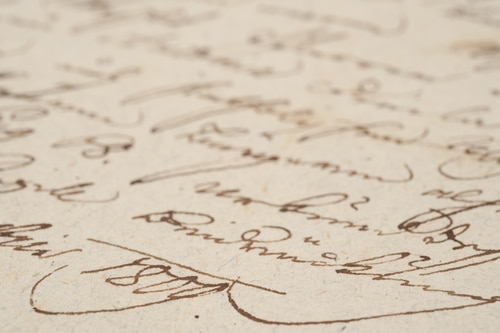
The Document Based Question (DBQ) essay is a key feature of the APUSH exam. And at 25% of your total score, it’s an important feature! Keep reading and you will get some great tips on how to write a DBQ for the APUSH exam.
What is a DBQ essay?
As I stated in a previous post on what the APUSH exam is all about , the goal of the exam is to test your historical thinking skills. Historians write arguments based on documents, and for this exam, you will, too.
For a DBQ essay, you will receive several documents of varying length. You will be asked to respond to some historical prompt that will require you to use the documents as evidence in your response. The great thing about a DBQ is that a lot of information you need to answer the question is in the documents themselves – score! However, you do need to have some background knowledge to make sense of the documents (we will practice this later in the post). The documents could be tables, charts, personal letters, or any other source that the exam creators believe would help you answer the question. Generally speaking, the documents will represent multiple perspectives on one topic.
It will be your job to synthesize those various perspectives into a coherent response.
Let’s walk through a sample DBQ topic for the APUSH exam.
Before we get too far into this, it’s important that you note that College Board, the organization that writes the APUSH exam, has made some major changes starting in 2015. I will be taking you through the 2015 sample the College Board provided for students to practice, but, as you will see in a second, it’s important that you practice as much as possible in order to read the documents quickly. Just make a note that the format may be slightly different if you review an exam prior to 2015.
Let’s say that you come across this prompt for a DBQ question:
Compare and contrast views of United States overseas expansion in the late nineteenth and early twentieth centuries. Evaluate how understandings of national identity, at the time, shaped these views.
Before you Read
You have 7 documents to read in the suggested time of 15 minutes. How is that even possible?!
Well, no one ever said it was going to be easy. But it is possible. When you get that prompt, or any other DBQ prompt like it, what you do before you read the documents will be just as important as what you end up writing. Before you even read the content of the documents, you should:
- Recall what you know about the time period.
- Read the source information for each document.
- Recognize the possible opinions that could be compared and contrasted.
Let’s dig into each of those steps.
1. Recall what you know
This DBQ is interested in U.S. overseas expansion in the late 19th and early 20th century. What do you know about U.S. overseas expansion during that time period? Perhaps you remember something about the Spanish-American War of 1898, which falls into our time period. Perhaps you remember that the U.S. got some territory as a result of that war. Even if you can’t remember exactly what territory, this puts you in a much better position to get started.
2. Read the source information
Take these two documents below as an example.
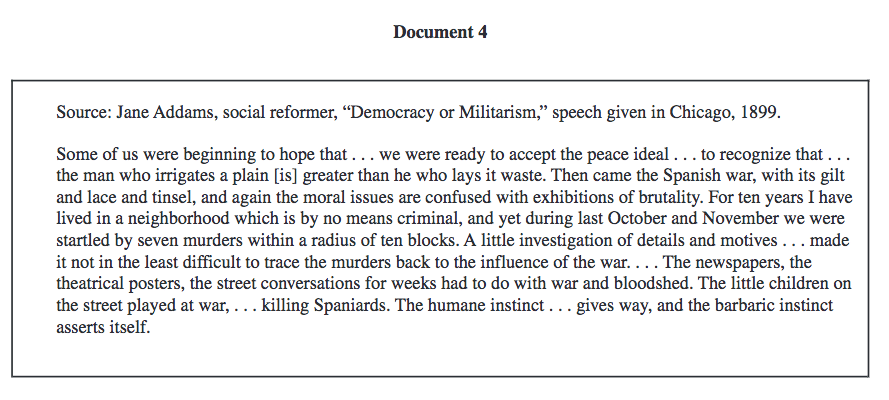
Before I read the document, I see that Jane Addams titled her speech “Democracy or Militarism.” Based on the title alone, I can begin to make some inferences that this document is not likely to be positive about any overseas expansion that would most certainly require military force.
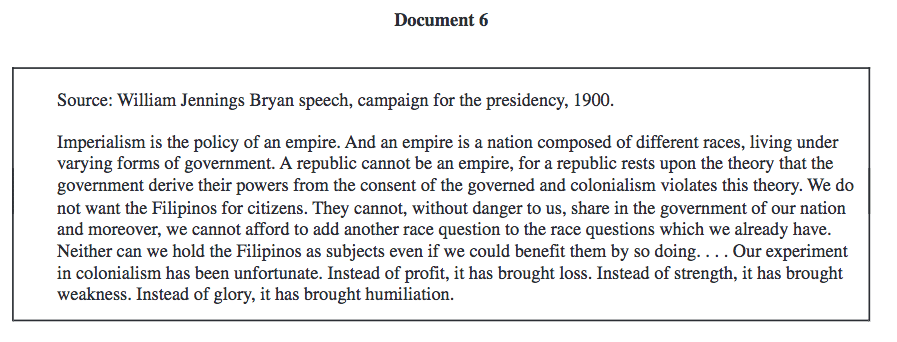
Before I even read this document, I can see that William Jennings Bryan is campaigning for the presidency. However, I cannot recall there ever being a President Bryan, meaning that he was unsuccessful in his campaign. Perhaps what he was saying was not popular enough to get enough votes.
These inferences help me make sense of the document later on.
3. Recognize possible opinions
Again, before I read the documents closely, I recognize that this is a compare/contrast question. Before I even read this document, I’m going to make the following table so that I can group documents later on.
| 1,2,3,etc | 1,2,3,etc | 1,2,3,etc |
This table will help me more easily write my essay.
I know that your instinct will be to see the clock and think, OH MY GOSH, I DON’T HAVE ENOUGH TIME TO BE DOING ALL THIS PREP WORK, MS. BERRY!!!!
Fight that instinct, because these steps will help you write a more coherent essay.
While you read
This part is tough. You have quite a few documents to make sense of in a short amount of time. But, as you are reading as fast as you can, you should be actively annotating the document for the following:
- Words, phrases, and/or visual cues that help you place the document into a group that helps you answer the question .
- Words, phrases, and/or visual cues that help you activate background knowledge .
- Words, phrases, and/or visual cues that help you understand the document’s bias .
You will have to practice this multiple times to get good at it; there’s really no way around that. But you have a plan of attack. So work your plan to make your plan work!
As you write
When you are writing your DBQ, use the five paragraph essay to your advantage. I am sure you know lots of other things that could turn this answer into a novel, but the most important thing for this task is to make sure that you get enough of your ideas on the page so that your APUSH exam scorer knows that you know.
- First paragraph: introduction with a thesis statement
- Second paragraph: documents FOR expansion (As you write, make sure to mention who is for expansion and compare/contrast that with who is against it.)
- Third paragraph: documents AGAINST expansion (As you write, make sure to mention who is against expansion and compare/contrast that with who is for it.)
- Fourth paragraph: documents with ambiguity or complicated arguments (You should compare these documents to BOTH groups.)
- Fifth paragraph: Conclusion that reiterates your argument
You may be thinking, why do I need that fourth paragraph? That seems needlessly complicated, to look for documents that are complicated.
Well, you are trying to score well on this DBQ, right? (Remember: it’s 25% of your overall score!)
You get a point for being able to do the following:
“Develop and support a cohesive argument that recognizes and accounts for historical complexity by explicitly illustrating relationships among historical evidence such as contradiction, corroboration, and/or qualification.” AP Scoring Guide
You will want that point!
I’ve given you a lot of information; but this information will become more like second nature the more you practice! For a summary, look at the table below.
And happy studying!
In summary: Strategies for writing the DBQ Essay
| While you Read | As you Write | |
|---|---|---|
| what you know about the time period. the source information for each document. the possible opinions that could be compared and contrasted. | Annotate: |
|

Allena Berry loves history; that should be known upfront. She loves it so much that she not only taught high school history and psychology after receiving her Master’s degree at Stanford University, she is now studying how students learn history at Northwestern. That being said, she does not have a favorite historical time period (so don’t bother asking). In addition to history, she enjoys writing, practicing yoga, and scouring Craigslist for her next DIY project or midcentury modern piece of furniture.
View all posts
More from Magoosh

Leave a Reply Cancel reply
Your email address will not be published. Required fields are marked *

- AP Calculus
- AP Chemistry
- AP U.S. History
- AP World History
- Free AP Practice Questions
- AP Exam Prep
AP World History: Sample DBQ Thesis Statements
Using the following documents, analyze how the Ottoman government viewed ethnic and religious groups within its empire for the period 1876–1908. Identify an additional document and explain how it would help you analyze the views of the Ottoman Empire.
Crafting a Solid Thesis Statement
Kaplan Pro Tip Your thesis can be in the first or last paragraph of your essay, but it cannot be split between the two. Many times, your original thesis is too simple to gain the point. A good idea is to write a concluding paragraph that might extend your original thesis. Think of a way to restate your thesis, adding information from your analysis of the documents.
Thesis Statements that Do NOT Work
There were many ways in which the Ottoman government viewed ethnic and religious groups.
The next statement paraphrases the historical background and does not address the question. It would not receive credit for being a thesis.
The Ottoman government brought reforms in the Constitution of 1876. The empire had a number of different groups of people living in it, including Christians and Muslims who did not practice the official form of Islam. By 1908 a new government was created by the Young Turks and the sultan was soon out of his job.
This next sentence gets the question backward: you are being asked for the government’s view of religious and ethnic groups, not the groups’ view of the government. Though the point-of-view issue is very important, this statement would not receive POV credit.
People of different nationalities reacted differently to the Ottoman government depending on their religion.
The following paragraph says a great deal about history, but it does not address the substance of the question. It would not receive credit because of its irrelevancy.
Throughout history, people around the world have struggled with the issue of political power and freedom. From the harbor of Boston during the first stages of the American Revolution to the plantations of Haiti during the struggle to end slavery, people have battled for power. Even in places like China with the Boxer Rebellion, people were responding against the issue of Westernization. Imperialism made the demand for change even more important, as European powers circled the globe and stretched their influences to the far reaches of the known world. In the Ottoman Empire too, people demanded change.
Thesis Statements that DO Work
Now we turn to thesis statements that do work. These two sentences address both the religious and ethnic aspects of the question. They describe how these groups were viewed.
The Ottoman government took the same position on religious diversity as it did on ethnic diversity. Minorities were servants of the Ottoman Turks, and religious diversity was allowed as long as Islam remained supreme.
This statement answers the question in a different way but is equally successful.
Government officials in the Ottoman Empire sent out the message that all people in the empire were equal regardless of religion or ethnicity, yet the reality was that the Turks and their version of Islam were superior.
Going Beyond the Basic Requirements
- have a highly sophisticated thesis
- show deep analysis of the documents
- use documents persuasively in broad conceptual ways
- analyze point of view thoughtfully and consistently
- identify multiple additional documents with sophisticated explanations of their usefulness
- bring in relevant outside information beyond the historical background provided
Final Notes on How to Write the DBQ
- Take notes in the margins during the reading period relating to the background of the speaker and his/her possible point of view.
- Assume that each document provides only a snapshot of the topic—just one perspective.
- Look for connections between documents for grouping.
- In the documents booklet, mark off documents that you use so that you do not forget to mention them.
- As you are writing, refer to the authorship of the documents, not just the document numbers.
- Mention additional documents and the reasons why they would help further analyze the question.
- Mark off each part of the instructions for the essay as you accomplish them.
- Use visual and graphic information in documents that are not text-based.
Don’t
- Repeat information from the historical background in your essay.
- Assume that the documents are universally valid rather than presenting a single perspective.
- Spend too much time on the DBQ rather than moving on to the other essay.
- Write the first paragraph before you have a clear idea of what your thesis will be.
- Ignore part of the question.
- Structure the essay with just one paragraph.
- Underline or highlight the thesis. (This may be done as an exercise for class, but it looks juvenile on the exam.)
You might also like

Call 1-800-KAP-TEST or email [email protected]
Prep for an Exam
MCAT Test Prep
LSAT Test Prep
GRE Test Prep
GMAT Test Prep
SAT Test Prep
ACT Test Prep
DAT Test Prep
NCLEX Test Prep
USMLE Test Prep
Courses by Location
NCLEX Locations
GRE Locations
SAT Locations
LSAT Locations
MCAT Locations
GMAT Locations
Useful Links
Kaplan Test Prep Contact Us Partner Solutions Work for Kaplan Terms and Conditions Privacy Policy CA Privacy Policy Trademark Directory
- Study Notes
- College Essays
AP English Notes
- Sample Essays
- Rhetorical Terms
- Bonus Knowledge
- Sample Thesis Statements
A thesis statement:
- tells the reader how you will interpret the significance of the subject matter under discussion.
- is a road map for the paper; in other words, it tells the reader what to expect from the rest of the paper.
- directly answers the question asked of you. A thesis is an interpretation of a question or subject, not the subject itself. The subject, or topic, of an essay might be World War II or Moby Dick; a thesis must then offer a way to understand the war or the novel.
- makes a claim that others might dispute.
- is usually a single sentence somewhere in your first paragraph that presents your argument to the reader. The rest of the paper, the body of the essay, gathers and organizes evidence that will persuade the reader of the logic of your interpretation.
Paragraph 1
In The Box Man , by Barbara Lazear Ascher, the protagonist reveals that a life of solitude need not always be lonely. Though the Box Man lives a life of solitude as a homeless wanderer, Ascher describes his “grand design” and “grandmotherly finger licking” to convince readers that their assumptions about homeless people are unfounded – and that they can live a dignified life. By describing the Box Man as “dignified” and “at ease”, Ascher paints a vivid picture of a man who chose a life a comfort and solitude and defeated loneliness by becoming his own friend.
Paragraph 2
In Upon the Burning of Our House , Anne Bradstreet ponders her unfortunate circumstances and appreciates that it was God’s will that her house burned to the ground. Bradstreet believed that every misfortune she encountered served to remind her of God’s will – in this case, she was reminded that “All is vanity” – a Biblical allusion meaning that everything in life is futile and the only worthy goal is entry into heaven. Bradstreet’s attitude is further revealed when she says “The world no longer let me love, / My hope and treasure lies above.” Bradstreet clearly feels that worldly life is fruitless; her sole concern is God.
Paragraph 3
In The Grapes of Wrath , John Steinbeck characterize the protagonist, Tom Joad, as a morally conscious person who stands up against evil. The image of Tom’s mother “slow with weariness” sitting and scraping potatoes affects Tom very much – so much that he is willing to give his life to rebel against the people who seek to harm his family. Through the use of imagery and diction, Steinbeck reveals Tom’s noble conscious and characterizes him as a rebellious – albeit rash – young man.
Paragraph 4
In the His Dark Materials Series by Philip Pullman, the setting is an essential element in the development and outcome of the plot in more ways than one. The protagonist, 11-year old Lyra Belacqua, lives in the precincts of Jordan College in Oxford growing up as an orphan among the old scholars. Her cheerful existence consisted of playing on the rooftops of the college and “waging war” with the local children. This contrasts sharply with the bright and exciting future she soon experiences after she escapes from the drudgery of college life. After escaping, Lyra begins a grand adventure, journeying to the north to meet armored bears, witches, and gyptians. The initial setting is important to the development of the plot because Lyra’s future resourcefulness and quick-wittedness in difficult situations were fine-tuned during the numerous challenges she faced as a child while fighting “wars” with the other local children. In addition, by understanding Lyra’s humble background, the reader can appreciate her future accomplishments.

You just finished Sample Thesis Statements . Nice work!
Previous Essay Next Essay
Tip: Use ← → keys to navigate!
How to cite this note (MLA)
More ap english sample essays.
- Sample Definition Essay - "Success"
- Sample Character Analysis Essay - "Hamlet"
- Essay Tips: Style Analysis - Tone of Voice Words
- Sample Compare and Contrast Essay - "Lincoln/Douglass"
- Sample Literary Devices Essay - "Things Fall Apart"
- Sample Character Analysis Essay - "Dead Poet's Society"
- Sample Compare and Contrast Essay - "Langston Hughes"
- Sample Informative Essay - "Great War"
- Sample Literary Devices Essay - "American Scholar"
- Essay Tips: Syntax - What to Say About It
- Sample Research Paper - "The Patriot Act"
- Sample Author Analysis Essay - "Edgar Allan Poe"
- Sample Cause and Effect Essay - "Great Gatsby"
- Sample Classification Essay - "Hamilton vs. Jefferson"
- Essay Tips: 5 Ways to Improve Your Essay Scores
- Violent Video Games are Not as Harmful as Parents Make Them Seem
- Sample Letter to the Editor - "Animal Rights"
- Morality: Fate Is Not In the Eye of the Beholder
- 475,521 views (111 views per day)
- Posted 12 years ago

IMAGES
VIDEO
COMMENTS
If you're not sure how to write a DBQ thesis, check out this post for a failproof DBQ thesis formula and AP World History and APUSH DBQ thesis examples!
Step 1: Analyze the Prompt. Each long essay question will ask you to "evaluate the extent" of some factor in American history. Since you are evaluating, you will need to develop an argument that addresses the prompt. Make sure to read all three prompts carefully. Think of the evidence you could use and the argument you could develop in ...
Resources from Heimler's History: To master all the WRITING SKILLS you need, get my ESSAY CRAM COURSE: +AP Essay CRAM Course (DBQ, LEQ, SAQ Help): https://bi...
Types of Thesis Statements: 1. Direct: This a straightforward statement that clearly and directly answers the question. To a remarkable degree Jacksonian democrats succeeded in implementing their vision of American society. 2. Compound: Use this approach when trying to prove two main points. Use the word "and.".
Start with a Clearly Stated Thesis. Some good essay writers begin with a thesis statement, back it up with supporting evidence from documents and outside knowledge, and, if time permits, restate the thesis at the end. Other writers analyze the material and build up logically to their thesis statement. On an AP Exam, you should use whichever ...
College Board's APUSH DBQ rubric recommends that you spend 15 minutes reading the documents and 45 minutes writing the essay . The best way to get your time management down is practice. Set timers during your APUSH DBQ practice test so you can get a feel for how much time it takes to put an answer together.
Use the documents and your knowledge of the years 1860-1877 to construct your response. This was the third DBQ we had written, and students were now getting brave enough to move beyond a thesis and document analysis and started attempting to tackle the contextualization point. However, the attempts were all over the map.
During Step 1: Analyze the Prompt. Use the 15-minute reading period to read the documents and organize them into groups for analysis. Feel free to write notes in the test booklet and underline important words in both the source line and the document itself. Nothing in the booklet is read as part of the essay scoring.
AP United States History. About Press Copyright Contact us Creators Advertise Developers Terms Privacy Policy & Safety How YouTube works Test new features NFL Sunday ...
No matter which type of essay you face, here are 4 steps to help you write a good APUSH long essay. Focus on Writing a Solid Thesis. Your thesis is the most important part. It's going to set up the entire essay. It's also the first thing that the grader is going to see, so start with a strong thesis! Your introductory paragraph should be ...
he first part of the thesis statement.Basic Complex-split thesis formula:Although (oth. r example) , ultimately (claim responding to prompt specifying 3 examples).Once you get used to writing a complex-split in th. anner, you can tweak the wording - but for now, stick to this formula. Example: Evaluate the main causes of World War 1 Simple ...
Short Answer: Multiply your raw short-answer score out of 9 by 3.33. DBQ: Multiply your raw DBQ score out of 7 by 5.36. Long Essay: Multiply your raw Long Essay score out of 6 by 3.75. Finally, add all the scores together to get your final scaled AP score for US History!
o earn this point, yo. r thesis must do three things:1. Respond to the promptYour thesis must be a specific answer to the actual prompt, not a variation of the prompt. or something more generally on the topic of the prompt. This means that you have to read the question multiple. mes and identify everything you must do to address it. It's a.
Step 2: Plan Your Response. Next, take time to plan your response. Check your plan against the long essay question requirements. See the sample plan that a high-scoring writer might make; scoring requirements are written in bold for reference. Step 3: Action! Write Your Response & Step 4: Proofread.
Thesis: Present a thesis that makes a historically defensible claim and responds to all parts of the question. The thesis must consist of one or more sentences located in one place, either in the introduction or the conclusion. ... Your thesis statement is the bread and butter of any essay you write for the APUSH exam. As I have stated before ...
As I stated in a previous post on what the APUSH exam is all about, the goal of the exam is to test your historical thinking skills. Historians write arguments based on documents, and for this exam, you will, too. For a DBQ essay, you will receive several documents of varying length. You will be asked to respond to some historical prompt that ...
Thesis Statement: When Thomas Jefferson became President in 1801, he strictly interpreted the Constitution. However, by the time of the Louisiana Purchase in 1803, Thomas Jefferson gradually loosened his hold on strict interpretation, and ultimately helped increase the power of the presidency by lessening his strict interpretation..
If you have looked at the new AP English rubrics, chances are you noticed that there is now a thesis point for each free response essay. This video offers ti...
Let's take a look at a sample AP World History DBQ question and techniques to construct a solid thesis. Using the following documents, analyze how the Ottoman government viewed ethnic and religious groups within its empire for the period 1876-1908. Identify an additional document and explain how it would help you analyze the views of the ...
Types of Thesis Statements: 1. Direct: This a straightforward statement that clearly and directly answers the question. To a remarkable degree Jacksonian democrats succeeded in implementing their vision of American society. 2. Compound: Use this approach when trying to prove two main points. Use the word "and.".
A thesis statement: tells the reader how you will interpret the significance of the subject matter under discussion. is a road map for the paper; in other words, it tells the reader what to expect from the rest of the paper. directly answers the question asked of you. A thesis is an interpretation of a question or subject, not the subject itself.
Khanmigo is now free for all US educators! Plan lessons, develop exit tickets, and so much more with our AI teaching assistant.
Khan Academy